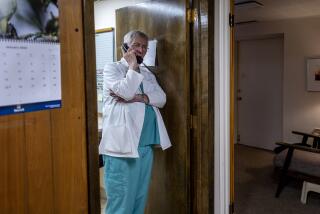Kevorkian’s Latest Act Raises New Concerns
- Share via
Is it worse to commit a murder than to assist in a suicide? In the eyes of the law, yes, there is a big difference. But in the realm of ethics, there is only a shade of distinction between the two acts. Some would say there is no difference at all.
After the CBS news program “60 Minutes” aired a videotape Sunday showing pathologist Jack Kevorkian injecting a dying man with a lethal toxin, Michigan county prosecutors announced they were investigating it as an apparent homicide. Kevorkian has claimed that since 1990 he has assisted 130 suicides, but this latest act goes beyond the role of accomplice.
No matter what the law decides in this case, in medical ethics--which studies norms of behavior and moral judgment--Kevorkian’s activities raise a different set of questions. Here, attention shifts from the doctor to the patient. The first concern is whether the patient freely chose the option. That opens a range of issues to explore, from why the person made the choice to whether he or she was competent at the time.
Religion-based ethics change the focus once again. In this case, the issue revolves around the value of life and the right of anyone to destroy his or her life, or that of another. The basic question is primal: “Who owns my body?”
To debate Kevorkian’s actions, obscure language has been reintroduced to daily conversation. In ancient Greece, “euthanasia” was the term for a legal, easy and painless death. Kevorkian’s techniques require some fine tuning of the language. Until this recent case, his “passive euthanasia” facilitated a suicide by setting up the machinery but then allowing the patient to push the button that activates it. “Active euthanasia” involves pushing the button for the patient.
Some medical ethicists say Kevorkian crossed a line when he administered the lethal injection because he pushed a civilized society one step closer to being a cannibal state.
“We live on a slippery slope where the ethical challenge is to put wedges at points we agree on,” says Dr. Mary Mahowald of the MacLean Center for Medical Ethics at the University of Chicago. “Kevorkian’s latest action amounts to the removal of the wedge.”
Mahowald leads weekly seminars in which students evaluate the ethics involved in medical case studies. Most of them have to do with end-of-life issues.
“The difference between giving you the medicine and administering it myself is an important one,” she says. “If I give it to you, there is always room for the possibility that you won’t take it.”
*
Looking at euthanasia from a faith-based perspective does not offer one universal answer. The most conservative religious teachings hold that it is never acceptable. Others allow for exceptions, although they start from the same premise.
“Our bodies belong to God,” says Elliot Dorff, rector of the University of Judaism. He has drafted several statements on euthanasia for the Conservative Movement’s Committee on Law and Standards. Because the body is not owned by the person, according to Conservative Judaism, a person has no right to take his life or another’s. There is no right to assist in another’s suicide, either. In Conservative Judaism, active euthanasia makes a person more culpable because it is manslaughter. By assisting a suicide, a person leads another astray but avoids the ultimate responsibility for a death. This is a lesser offense, from a moral point of view, Dorff says.
Roman Catholic leaders have been similarly outspoken against euthanasia. Sister Paula Vandegaer, who chairs the commission for Catholic Life Issues in this archdiocese, refused to even watch the Kevorkian tape. She considers it “a snuff film.”
*
Catholic teaching holds no distinction between assisted suicide and active euthanasia, Vandegaer says.
“God is the author of life. God decides when our work on Earth is finished,” she says. “Until that moment, we believe, God continues to renew and perfect each of us. A great deal of healing goes on in the last phase, both for the dying and the loved ones around them.”
By his very public acts, Kevorkian has forced urgent health-care problems to the center of attention. Most of them have to do with how we treat the dying. Lack of adequate pain medication and lack of support for good nursing homes, spiritual care and hospices--in which the dying are allowed to end life naturally, with pain control--are key concerns.
Some doctors who oppose euthanasia are such strong advocates of pain control that they allow for the possibility of death by overmedication, within restricted conditions. If a doctor is aggressively treating physical pain, it can cause death.
“It is a risk, but we take risks in medicine all the time, putting baboon hearts in humans and all sorts of things,” says Art Caplan, director of the Center for Bioethics at the University of Pennsylvania. “The closer to death a patient is, the more the medicine cabinet should be opened up to them.”
*
With several states, including Washington, California and Kevorkian’s home state of Michigan, placing assisted suicide referendums on recent election ballots, Caplan expects to see it legalized slowly, state by state. To date, assisted suicide is legal only in Oregon. As states take up the debate, Kevorkian’s media-staged acts will become irrelevant. The issue will have outgrown him.
“I’d like to see assisted suicide as the last option,” Caplan says. “It would be nice if ‘the right to health care’ became more important than ‘the right to die.’ ”
Bedside Manner: * Dr. Jack Kevorkian should have watched Tuesday’s “NYPD Blue,” TV critic Howard Rosenberg says. F1
More to Read
Sign up for Essential California
The most important California stories and recommendations in your inbox every morning.
You may occasionally receive promotional content from the Los Angeles Times.










